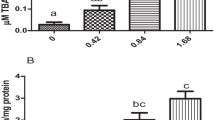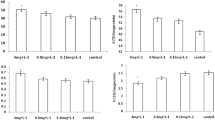Abstract
The neurotoxin domoic acid (DA) is produced by Pseudo-nitzschia spp. during harmful algal blooms and is linked to amnesic shellfish poisoning. This toxin is particularly problematic in the culture of bivalves for human consumption. In this study, we exposed bay scallops to 20, 40, and 60 ng/ml DA and examined toxin accumulation and stress response at 3, 6, 12, 24, 36, and 48 h of exposure. Oxidative stress was determined by measuring the levels of superoxide dismutase (SOD), catalase (CAT), heat shock protein 90 (HSP90), and metallothionein (MT) in the digestive diverticula and/or hemolymph and by determining H2O2 concentration in hemolymph. We also observed histological changes to gills following exposure to DA in order to determine changes in melanization. We found that scallops accumulated a maximum of 2.61 ng/ml DA in their digestive diverticula when exposed to 60 ng/ml. Stress indices rose under higher DA concentrations, and HSP levels increased under exposure to higher concentrations of DA. However, mRNA expression and activity of other stress parameters showed peaks at different times during exposure, with subsequent declines. Epithelial melanization of gills indicated a strong positive response to DA at 60 ng/ml for 48 h (P < 0.05). These results indicate that exposure to DA induces oxidative stress, disrupts metabolism, and has negative effects on the defense systems of bay scallops.






Similar content being viewed by others
References
Anderson D (2014) HABs in a changing world: a perspective on harmful algal blooms, their impacts, and research and management in a dynamic era of climatic and environmental change. In: Kim HG, Reguera B, Hallegraeff GM, Lee CK, Han MS, Choi JK (eds) Harmful Algae 2012, Proc 15th International Conference on Harmful Algae. International Society for the Study of Harmful Algae, Busan, pp 3–17
Barber BJ, Davis CV (1997) Growth and mortality of cultured bay scallops in the Damariscotta River, Maine (USA). Aquacult Int 5:451–460
Bates SS, Bird CJ, de Freitas ASW, Foxall R, Gilgan M, Hanic LA, Johnson GR, McCulloch AW, Odense P, Pocklington R, Quilliam MA, Sim PG, Smith JC, Subba Rao DV, Todd ECD, Walter JA, Wright JLC (1989) Pennate diatom Nitzschia pungens as the primary source of domoic acid, a toxin in shellfish from eastern Prince Edward Island, Canada. Can J Fish Aquat Sci 46:1203–1215
Bauder AG, Cembella AD, Bricelj VM, Quilliam MA (2001) Uptake and fate of diarrhetic shellfish poisoning toxins from the dinoflagellate Prorocentrum lima in the bay scallop Argopecten irradians. Mar Ecol Prog Ser 213:39–52
Brown HM, Briden A, Stokell T, Griffin FJ, Cherr GN (2004) Thermotolerance and HSP70 profiles in adult and embryonic California native oysters, Ostreola conchaphila (Carpenter, 1857). J Shellfish Res 23:135–141
Chen J, Mai K, Ma H, Wang X, Deng D, Liu X, Xu W, Liufu Z, Tan B (2007) Effects of dissolved oxygen on survival and immune responses of scallop (Chlamys farreri Jones et Preston). Fish Shellfish Immunol 22:272–281
Chi C, Jiang B, Yu XB, Liu TQ, Xia L, Wang GX (2014) Effects of three strains of intestinal autochthonous bacteria and their extracellular products on the immune response and disease resistance of common carp, Cyprinus carpio. Fish Shellfish Immunol 36:9–18
Chi C, Giri S, Jun J, Kim H, Yun S, Kim S, Park S (2016) Marine toxin okadaic acid affects the immune function of bay scallop (Argopecten irradians). Molecules 21:1108
Cranford PJ (2006) Scallops and marine contaminants. In: Shumway SE, Parsons GJ (eds) Scallops: biology, ecology and aquaculture. Elsevier, Amsterdam, pp 745–764
Douglas DJ, Kenchington ER, Bird CJ, Pocklington R, Bradford B, Silvert W (1997) Accumulation of domoic acid by the sea scallop (Placopecten magellanicus) fed cultured cells of toxic Pseudo-nitzschia multiseries. Can J Fish Aquat Sci 54:907–913
Escobedo-Lozano AY, Estrada N, Ascencio F, Contreras G, Alonso-Rodriguez R (2012) Accumulation, biotransformation, histopathology and paralysis in the Pacific Calico Scallop Argopecten ventricosus by the paralyzing toxins of the Dinoflagellate Gymnodinium catenatum. Mar Drugs 10:1044–1065
Estrada N, Romero MJ, Campa-Córdova A, Luna A, Ascencio A (2007) Effects of the toxic dinoflagellate, Gymnodinium catenatum on hydrolytic and antioxidant enzymes, in tissues of the giant lions-paw scallop Nodipecten subnodosus. Comput Biochem Physiol C 146:502–510
Frantzen M, Regoli F, Ambrose WG, Nahrgang J, Geraudie P, Benedetti M, Locke VWL, Camus L (2016) Biological effects of mechanically and chemically dispersed oil on the Icelandic scallop (Chlamys islandica). Ecotoxicol Environ Saf 127:95–107
Gao Q, Zhao J, Song L, Qiu L, Yu Y, Zhang H, Ni D (2008) Molecular cloning, characterization and expression of heat shock protein 90 gene in the haemocytes of bay scallop Argopecten irradians. Fish Shellfish Immunol 24:379–385
Hallegraeff GM (2010) Ocean climate change, phytoplankton community responses, and harmful algal blooms: a formidable predictive challenge. J Phycol 46:220–235
Hannam ML, Bamber SD, Moody JA, Galloway TS, Jones MB (2009) Immune function in the Arctic Scallop, Chlamys islandica, following dispersed oil exposure. Aquat Toxicol 92:187–194
Hégaret H, Wikfors GH (2005) Time-dependent changes in hemocytes of eastern oysters, Crassostrea virginica, and northern bay scallops, Argopecten irradians irradians, exposed to a cultured strain of Prorocentrum minimum. Harmful Algae 4:187–199
Hoagland P, Scatasta S (2006) The economic effects of harmful algal blooms. Ecology of harmful algae. Springer, Berlin, pp 391–402
Huang Y, Cai X, Zou Z, Wang S, Wang G, Wang Y (2014) Molecular cloning, characterization and expression analysis of three heat shock responsive genes from Haliotis diversicolor. Fish Shellfish Immunol 36:590–599
James KJ, Carey B, O’halloran J, Škrabáková Z (2010) Shellfish toxicity: human health implications of marine algal toxins. Epidemiol Infect 138:927–940
Kashiwagi A, Kashiwagi K, Takase M, Hanada H, Nakamura M (1997) Comparison of catalase in diploid and haploid Rana rugosa using heat and chemical inactivation techniques. Comput Biochem Physiol B 118:499–503
Lelong A, Hégaret H, Soudant P, Bates SS (2012) Pseudo-nitzschia (Bacillariophyceae) species, domoic acid and amnesic shellfish poisoning: revisiting previous paradigms. Phycologia 51:168–216
Liu H, Kelly MS, Campbell DA, Dong SL, Zhu JX, Wang SF (2007) Exposure to domoic acid affects larval development of king scallop Pecten maximus (Linnaeus, 1758). Aquat Toxicol 81:152–158
Liu H, Kelly MS, Campbell DA, Fang JG, Zhu JX (2008) Accumulation of domoic acid and its effect on juvenile king scallop Pecten maximus (Linnaeus, 1758). Aquaculture 284:224–230
Mafra LL Jr, Bricelj VM, Ouellette C, Léger C, Bates SS (2009) Mechanisms contributing to low domoic acid uptake by oysters feeding on Pseudo-nitzschia cells. I. Filtration and pseudofeces production. Aquat Biol 6:201–212
Mafra LL Jr, Bricelj VM, Ouellette C, Bates SS (2010) Feeding mechanics as the basis for differential uptake of the neurotoxin domoic acid by oysters, Crassostrea virginica, and mussels, Mytilus edulis. Aquat Toxicol 97:160–171
Manfrin C, Dreos R, Battistella S, Beran A, Gerdol M, Varotto L, Lanfranchi G, Venier P, Pallavicini A (2010) Mediterranean mussel gene expression profile induced by okadaic acid exposure. Environ Sci Technol 44:8276–8283
Miles AT, Hawksworth GM, Beattie JH, Rodilla V (2000) Induction, regulation, degradation, and biological significance of mammalian metallothioneins. Crit Rev Biochem Mol Biol 35:35–70
Parsons ML, Dortch Q, Turner RE (2002) Sedimentological evidence of an increase in Pseudo-nitzschia (Bacillariophyceae) abundance in response to coastal eutrophication. Limnol Oceanogr 47:551–558
Perl TM, Bédard L, Kosatsky T, Hockin JC, Todd EC, Remis RS (1990) An outbreak of toxic encephalopathy caused by eating mussels contaminated with domoic acid. N Engl J Med 322:1775–1780
Qiu J, Ma F, Fan H, Li A (2013) Effects of feeding Alexandrium tamarense, a paralytic shellfish toxin producer, on antioxidant enzymes in scallops (Patinopecten yessoensis) and mussels (Mytilus galloprovincialis). Aquaculture 396:76–81
Todd ECD (1993) Domoic acid and amnesic shellfish poisoning—a review. J. Food Protect 56:69–83
Trainer VL, Bates SS, Lundholm N, Thessen AE, Cochlan WP, Adams NG, Trick CG (2012) Pseudo-nitzschia physiological ecology, phylogeny, toxicity, monitoring and impacts on ecosystem health. Harmful Algae 14:271–300
Van Dolah FM (2000) Marine algal toxins: origins, health effects, and their increased occurrence. Environ Health Perspect 108:133–141
Vargas-Albores F, Barracco MA (2001) Mecanismos de Defensa de los Moluscos Bivalvos, con Énfasis en Pectínidos. In: Los Moluscos Pectínidos de Iberoamérica: Ciencia y Acuicultura; Maeda-Martínez AN (ed). Limusa: Mexico City, pp 127–146 (in Spanish with English abstract)
Wang L, Song L, Ni D, Zhang H, Liu W (2009) Alteration of metallothionein mRNA in bay scallop Argopecten irradians under cadmium exposure and bacteria challenge. Comp Biochem Physiol C 149:50–57
Zabaglo K, Chrapusta E, Bober B, Kaminski A, Adamski M, Bialczyk J (2016) Environmental roles and biological activity of domoic acid: a review. Algal Res 13:94–101
Acknowledgements
This research was supported by the project titled ‘Development and commercialization of high density low temperature plasma based seawater sterilization pulification system’ funded by the Ministry of Oceans and Fisheries, and by Korea Institute of Ocean Science and Technology (PE99832), Republic of Korea.
Author information
Authors and Affiliations
Corresponding author
Ethics declarations
Conflict of interest
The authors declare that they have no conflict of interests.
Additional information
Publisher's Note
Springer Nature remains neutral with regard to jurisdictional claims in published maps and institutional affiliations.
Electronic supplementary material
Below is the link to the electronic supplementary material.
Rights and permissions
About this article
Cite this article
Song, J.A., Choi, C.Y. & Park, HS. Exposure to domoic acid causes oxidative stress in bay scallops Argopecten irradians. Fish Sci 86, 701–709 (2020). https://doi.org/10.1007/s12562-020-01431-3
Received:
Accepted:
Published:
Issue Date:
DOI: https://doi.org/10.1007/s12562-020-01431-3




